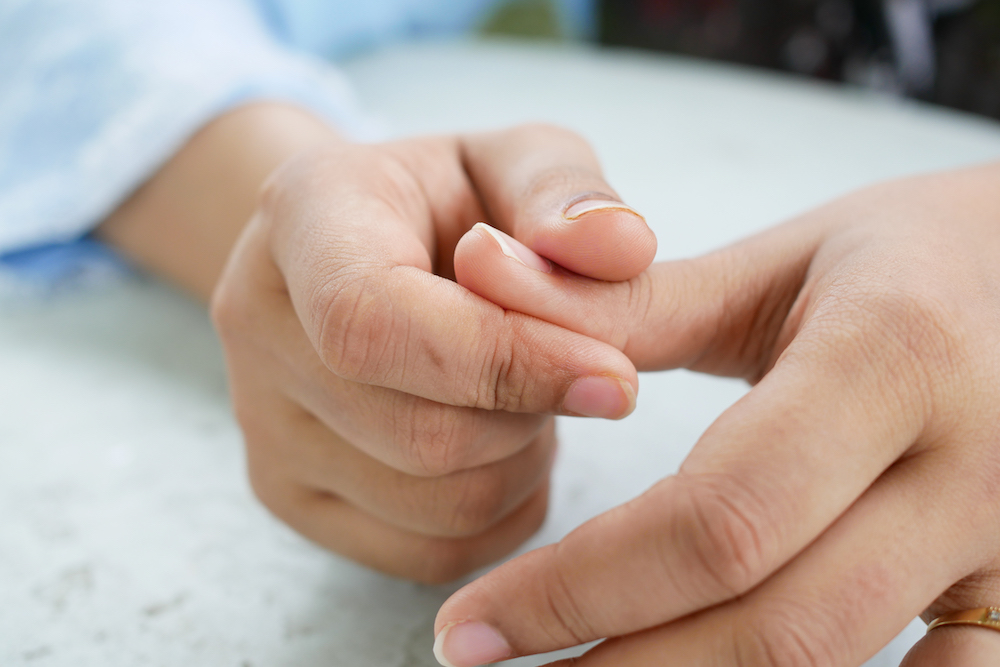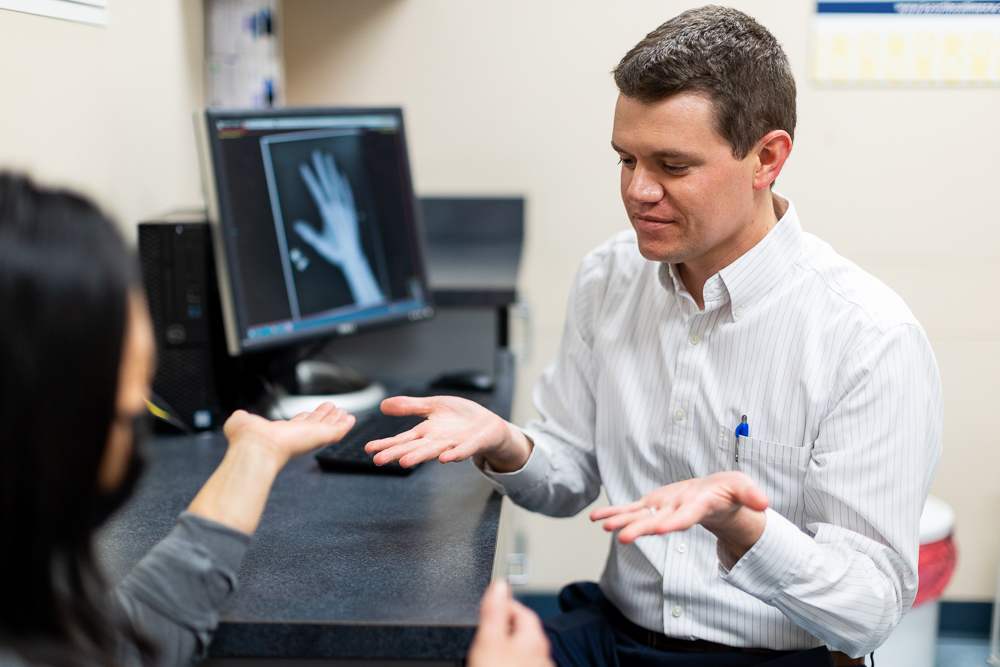
Despite their small size, our fingers play a major role in our daily functioning. From typing and writing to securely gripping objects, our fingers allow us to perform any task that comes our way.
It’s easy to overlook the importance of our fingers—until they stop working properly. After sustaining a finger injury, you quickly realize how such a small bone can completely disrupt your daily routine.
Broken fingers are the most common sports-related fractures in adults and teenagers in the United States. But you don’t have to be an athlete for a fracture to occur—broken fingers can happen as a result of a fall, catching your finger in a door or drawer, or other physical trauma.
If you suspect you may have a broken finger, it’s important to seek proper medical attention. Leaving finger injuries untreated can lead to poor healing and further complications down the road.
Kansas City Orthopedic Alliance is the Midwest’s premier provider of orthopedic care. As the largest orthopedic practice in Kansas City, we treat thousands of patients each year across our 5 locations: Overland Park, Leawood, Belton, Kansas City, and Blue Springs. Using the latest technology, our physicians can evaluate, diagnose, and treat nearly any type of hand injury.
In this blog, our orthopedic experts will discuss finger fractures, what you should do after an injury occurs, and the treatments that can help you get back on track.
Finger Fractures
A finger fracture (also known as a broken bone) often occurs after an injury to the hand. Common causes of a broken finger include:
- Falls on an outstretched hand
- Sports-related injuries (ex: your finger jams when catching a ball or is hit by a fast-moving ball)
- Crushing injuries (ex: your finger gets caught in a door or underneath a heavy object)
- Trauma that impacts your finger (such as a car accident)
- Accidents with power tools or a hammer
Fractures vary in severity, depending on the type of fracture you experience. Bones can break in various ways, including:
- In a straight line
- Into several pieces
- In a spiral pattern
The type of fracture you experience will greatly influence your symptoms and your treatment.
Symptoms
Symptoms of a broken finger can include:
- Pain at the site of the fracture (that typically worsens with movement or pressure)
- Swelling around the finger
- Bruising around the fracture site
- Visible deformity of the finger
- Limited range of motion
- Tenderness
- Open wounds or visible bone protrusion (in severe fractures)
In some cases, patients who have a broken finger are still able to move it (despite some pain). Even if the pain is tolerable, it is important to seek medical attention after a finger injury. This will increase the likelihood of proper diagnosis and healing.
Diagnosis
To get an accurate diagnosis, it’s important to visit an orthopedic clinic. During your appointment, your physician will:
1. Ask Questions About the Injury
Your physician will first gather information about your pain and how the injury occurred. Your answers help guide our diagnosis and treatment.
We often ask questions such as:
- How did the injury occur?
- How does your pain limit you or your activities?
- Has your pain improved or gotten worse?
- Did you hear a popping sound at the time of injury?
- Have you noticed any changes in your symptoms?
2. Complete a Physical Exam
Next, your provider will complete a physical exam to look for signs of a finger fracture (and other potential injuries). This exam may include:
- Visually inspecting the finger to look for abnormalities, swelling, or bruising
- Pressing on the finger to locate areas of tenderness or bone abnormalities
- Asking you to move your finger to assess your range of motion
- Performing stability testing to check for joint stability

From your physical examination, your provider will be able to determine if further diagnostic testing is necessary.
3. Order Diagnostic Tests
If warranted, your doctor will order an X-ray to confirm a diagnosis and guide the treatment plan. At KCOA, we offer in-clinic imaging to get you the answers you need quickly. The sooner we can diagnose your injury, the sooner we can start treatment and get you back to your daily activities.
In rare cases, your broken finger may require an MRI. If this is the case, our staff will help you schedule a timely imaging appointment.
Treatments
Finger fractures require treatment from an orthopedic physician. Depending on the severity of your injury, you may need one or more of the following treatments:
- Splinting and/or taping the finger to the one next to it
- A procedure to align the fragments of the fracture
- Rest, elevation, and ice
- Medications to alleviate the pain
- Physical or occupational therapy
- Surgery (if the fracture is complex)
The best treatment for you will depend on the type of fracture, the location of the fracture, and factors such as your age and overall health. At Kansas City Orthopedic Alliance, our hand specialists use nonsurgical fracture management whenever possible.
Other Finger Injuries
Finger pain can stem from various types of injuries that aren’t a broken finger. Other common finger injuries include:
Bruises
Bruises appear when blood vessels break and release blood underneath the skin. While bruises are typically considered a minor injury, they can be painful and often require time to heal.
Causes
The most common cause of a finger bruise is trauma to the finger, such as:
- Getting your finger caught in a car door
- Smashing your finger under a heavy object
- Hitting your finger against a doorframe
Symptoms
Symptoms of a finger bruise can include:
- Pain that increases when using or putting pressure on the finger
- Purple, blue, green, or yellow discoloration
- Swelling around the site of injury
Treatments
A bruised finger needs time to rest and heal. To alleviate pain and speed up the healing process, you should:
- Avoid using the finger excessively (especially for activities that caused the bruise)
- Apply ice to the bruised area in 20-minute increments
- Elevate your hand to reduce swelling
- Talk to your doctor about using over-the-counter pain relievers
If you’re experiencing severe pain or the above treatments don’t improve your symptoms, it’s important to seek medical care from an orthopedic provider for further examination.
Dislocations
Dislocations occur when the bones of a finger are forced out of their normal position. If you think you may have a dislocated finger, it’s important to seek medical treatment from an orthopedic urgent care or emergency room.
Causes
Finger dislocations most commonly occur when there is a direct blow to the finger. This can happen during:
- Sports
- Falls
- Pinching your finger in a vehicle door or closing a window
Symptoms
One of the hallmark symptoms of a finger dislocation is a visible deformity in the finger joint. Your finger may look like it’s bending in the wrong direction or that it is out of its normal position. Other symptoms of a dislocation can include:
- Appearing misaligned
- Sharp pain at the site of the dislocation
- Swelling around the dislocated joint
- Bruising or discoloration
- Reduced range of motion
- Difficulty straightening or bending the finger
Treatments
A dislocated finger requires immediate medical attention. Your provider may offer the following treatments:
- A technique to realign the dislocated joint
- Splinting
- Follow-up care including rest, elevation, icing, and medications
Tendon Injuries
Tendon injuries of the finger can include tendonitis, trigger finger, mallet finger, and more. If you suspect you have a tendon injury, it’s important to schedule an appointment with an orthopedic hand specialist.
Causes
Tendon injuries can occur due to:
- Overuse or repetitive movements
- Direct impact or crushing injuries to the hand
- Accidents involving sharp objects that cut tendons
- Age-related changes
Symptoms
Symptoms of a tendon injury can include:
- Pain that can be sharp, dull, throbbing, or aching
- Swelling around the affected finger
- Stiffness and limited range of motion
- Weakness of the affected finger
- Clicking or popping sensations
- Pain with movement
Treatments
If you think your finger pain is caused by a tendon injury, it’s essential to visit an orthopedic specialist. They can offer treatments to alleviate your pain, including:
- Immobilization with a splint or brace
- Medications
- Physical therapy
- Hand exercises
- Corticosteroid injections
- Activity modification
Regardless of your injury, an orthopedic clinic can diagnose your pain and start a treatment plan to help you heal. If you need immediate treatment for your injury, visit an orthopedic urgent care for expert assistance.
If You Have a Broken Finger, Kansas City Orthopedic Alliance Can Help.
At Kansas City Orthopedic Alliance, we’re dedicated to creating a superior patient experience for all. Whether you need treatment from a hand specialist or a sports medicine physiatrist in Kansas City, our team will help ensure the best possible outcomes.
We’ve helped thousands of patients treat their pain, restore their function, and improve their quality of life. If you are ready to stop living with finger pain, take the first step by contacting KCOA today.
For a thorough evaluation, call us at (913) 319-7600 or schedule an appointment today. If you’re struggling with pain but don’t know where to start, use our symptom tracker for treatment recommendations.


